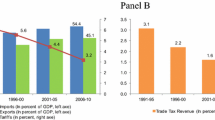Abstract
We examine the potential for further reform of sales tax and tariffs on final goods and on intermediate inputs in Pakistan. Analysis is conducted at two levels. First, optimal taxes are computed under the assumption that tax revenue is exogenous and pays for a public good, and these are compared with their current levels. Second, we consider two piecemeal reform exercises to examine whether there is further scope for replacing the two tariffs by sales tax in a revenue-neutral way. Both approaches suggest that there is considerable scope for further reducing tariffs on final goods, but not on intermediate inputs.
Similar content being viewed by others
References
Abe, K. (1992). “Tariff Reform in a Small Open Economy with Public Production,” International Economic Review 33, 209–222.
Ahmad, E., S. Ludlow and N. Stern. (1988). “Demand Response in Pakistan: A Modification of the Linear Expenditure System for 1976,” The Pakistan Development Review 27, 293–307.
Ahmad, E. and N. Stern. (1991). The Theory and Practice of Tax Reform in Developing Countries. Cambridge: Cambridge University Press.
Ballard, C., J. Shoven and J. Whalley. (1985). “General Equilibrium Computations of the Marginal Welfare Cost of Taxes in the United States,” American Economic Review 75, 128–138.
Baumol, W. J. and D. F. Bradford. (1970). “Optimal Departures from Marginal Cost Pricing,” The American Economic Review 60, 265–283.
Buffie, E. F. (2001). Trade Policy in Developing Countries. Cambridge University Press.
Dixit, A. K. and V. Norman. (1980). Theory of International Trade. Welwyn: Nisbet.
Fullerton, D. (1991). “Reconciling Recent Estimates of the Marginal Welfare Cost of Taxation,” American Economic Review 82, 302–308.
Goldstein, M. and M. S. Khan. (1985). “Income and Price Effects in Foreign Trade.” In P.B. Kennen and R.W. Jones (eds.), Handbook of International Economics, Amsterdam: North-Holland, pp. 1041–1105.
Government of Pakistan. CBR Year Book (various issues). Islamabad: Central Board of Revenue.
Government of Pakistan. Economic Survey (various issues). Islamabad: Finance Division.
Government of Pakistan. 50 Years of Pakistan in Statistics. Islamabad: Federal Bureau of Statistics.
Government of Pakistan. Pakistan Statistical Yearbook 2001. Islamabad: Federal Bureau of Statistics.
Keen, M. and S. Lahiri. (1998). “The Comparison Between Destination and Origin Principles under Imperfect Competition,” Journal of International Economics 45, 323–350.
Keen, M. and J. E. Ligthart. (2002). “Coordinating Tariff Reduction and Domestic Tax Reform,” Journal of International Economics 56, 489–507.
Krishna, P. and A. Panagariya. (1997). “A Unification of the Theory of Second Best,” Working Paper No. 31, Center for International Economics, Department of Economics, University of Maryland.
Lahiri, S., A. Nasim and J. Ghani. (2000). “Optimal Second-Best Tariffs on an Intermediate Input with Particular Reference to Pakistan,” Journal of Development Economics 61, 393–416.
Lahiri, S. and P. Raimondos. (1996). “Correcting Trade Distortions in a Small Open Economy,” Review of International Economics 4, 287–299.
LLoyd, P. J. (1974). “A More General Theory of Price Distortions in Open Economies,” Journal of International Economics 4, 365–386.
López, R. and A. Panagariya. (1992). “On the Theory of Piecemeal Tariff Reform: The Case of Pure Imported Intermediate Inputs,” American Economic Review 82, 615–625.
López, R. and D. Rodrik. (1990). “Trade Restrictions with Imported Intermediate Inputs: When Does the Trade Balance Improve?” Journal of Development Economics 34, 329–338.
Michael, M. S., P. Hatzipanayotou and S. M. Miller. (1993). “Integrated Reforms of Tariffs and Consumption Taxes,” Journal of Public Economics 52, 417–428.
Panagariya, A., S. Shah and D. Mishra. (2001). “Demand Elasticities in International Trade: Are They Really Low?” Journal of Development Economics 64, 313–342.
Rodrik, D. (1992). “The Limits of Trade Policy Reform in Developing Countries,” Journal of Economic Perspective 6, 87–105.
The World Bank. (2003). “Trade Policies in South Asia,” Draft Report.
Wilson, J. D. (1991). “Optimal Public Good Provision with Limited Lump-Sum Taxation,” American Economic Review 81, 153–166.
World Trade Organisation. (2001). Trade Policy Review Body—Trade Policy Review, Pakistan—Report by the Secretariat, http://docsonline.wto.org/.
Author information
Authors and Affiliations
Corresponding author
Additional information
JEL Code: F1, O2, O5
Rights and permissions
About this article
Cite this article
Lahiri, S., Nasim, A. Commercial Policy Reform in Pakistan: Opening up the Economy under Revenue Constraints. Int Tax Public Finan 12, 723–739 (2005). https://doi.org/10.1007/s10797-005-0486-8
Issue Date:
DOI: https://doi.org/10.1007/s10797-005-0486-8




